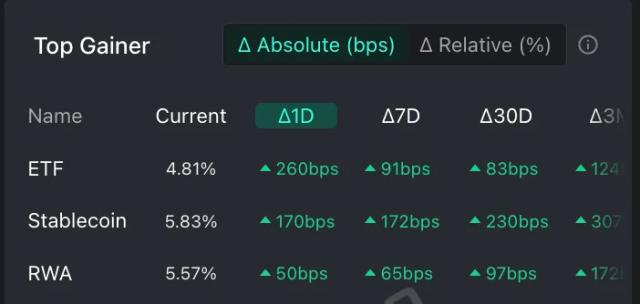Title: Resolv 2025 and Beyond
Author: @I v4 n_Ko, Founder of @ResolvLabs
Translated by: zhouzhou, BlockBeats
Editor's Note: This article discusses key issues in stablecoin development, such as revenue sources, risk isolation, and distribution strategies. The author points out that strategies relying on limited market capacity and centralized exchanges have a ceiling, thus requiring more diverse revenue channels (such as LSTs, LRTs, etc.) and decentralized risk management mechanisms. By introducing methods similar to Tranching to layer risks, stablecoins can become more robust. The article also emphasizes the importance of network effects and distribution channels, believing that future stablecoin competition will focus on compliance and global expansion capabilities.
Following is the original content (slightly edited for readability):
We are accustomed to stablecoin market leaders being "transaction-oriented". Indeed, USDT and USDC excel in payments and entry/exit. However, we have merely scratched the surface of a potentially larger use case. This underestimated narrative is the "investment-oriented" stablecoin, driven by broader crypto-native returns. They have replaced traditional treasuries, becoming the perfect channel for stable crypto yields.
By adopting a flexible hybrid approach to obtain these yields, Resolv aims to establish a true yield momentum center. Our goal is to provide infrastructure for comprehensive investment solutions that grow with the industry. This is our professional domain and our passion.
The yield-generating stablecoin market will become massive, as cryptocurrencies can be an excellent alpha source with a global asset base. However, two main obstacles still hinder this potential's growth: scalability and risk. Scalability is limited because on-chain markets are relatively small—yields compress quickly.
Cryptocurrency risk remains a "nightmare" in traditional finance: for many, even a 5-times return is insufficient to "touch cryptocurrencies". We need to build a yield generation solution that can scale with the market while keeping crypto-related risks within controllable limits.
[Rest of the translation follows the same professional and accurate approach]
Compared to the structure of traditional financial products, stablecoins are almost superior in every aspect: liquidity, transferability, capital efficiency (you can use them as collateral and create leverage), and self-custody.

Let's try to imagine potential users as a continuous spectrum.
On the left are crypto-native users, farmers, and power users, while on the right are elderly people who hide cash under their pillows (along with some conservative family offices and hedge funds). As we move along this spectrum, we encounter more "sticky" users.
Starting from the liquidity flywheel and crypto-native mechanisms, the goal is to continuously move to the right by penetrating more traditional channels (such as new-type banks). This is our primary objective for the coming years, as global permissions are gradually advanced and established.
In the crypto field, network effects provide excess returns, so the ability to convert other market participants into your distribution agents is a huge advantage.
By allowing third parties to participate in revenue generation (as strategy initiators or risk managers), Resolv is expanding the network effect. Look at how Morpho introduces new product opportunities and liquidity through risk managers, thereby promoting growth. Similarly, Pendle's liquidity flywheel drives project integration, further increasing network effects.
We see many projects trying to build a "vertical moat" by controlling various stages of value generation, keeping economic benefits in their own hands, but consequently becoming unable to collaborate and expand with other projects.
In contrast, we will establish a "horizontal moat" where distribution and income generation will benefit all participants. We aim to remain as neutral as possible in this process to optimize the best product output.
Stablecoins inherently have distribution advantages, which are further amplified by network effects.
A Note on Relevance
For any crypto project, there's an "elephant in the room" - that is, the moat, the ability to stay in sync with the market, and maintain relevance. We believe this is a massive issue because many projects gradually fade into obscurity after a few years of narrative. To stay ahead of competitors in the super dynamic crypto market, you must be able to integrate new revenue sources and leverage emerging narratives. This is precisely what we can achieve through our modular approach.
Don't forget that token incentives are also an important source of crypto returns. Liquidity moves from one project to another, seeking early liquidity incentive drops and massive APYs. By distributing liquidity to broader revenue sources (projects), we can also capture this portion.

Roadmap
Looking ahead, it's always exciting to see how big things develop, but there's still much specific work to be done. Let's look at the plans for the next few months.
Our plans are consistent with the key elements mentioned earlier - these elements include revenue sources, risks, and distribution.
First, we are integrating with Superstate, a process currently underway. This is our first collaboration with a third-party revenue source, through which we can benefit from more stable and diversified interest rates.
To broaden the asset base, we will add BTC as a base asset to our portfolio. Our focus on on-chain methods allows us to use different BTC LSTs / LRTs in stablecoin support, so we anticipate more partnerships and higher returns driven by related solutions.
In terms of distribution, our goal is to place our products where demand is strongest, so expanding to new chains and emerging ecosystems is an important part of our growth. Currently, our TVL on Base has exceeded $150 million, and we are HyperBullish, but more progress is yet to come.
Additionally, don't forget other distribution channels like wallets and CEX (more news about this will come soon). Another major liquidity source comes from crypto projects' treasury reserves (managed by asset management companies like Karpatkey) and funds supporting other stablecoins.








